Definitions
Order is not only alphabetical but also by topic so use find ( Ctrl-f)
Address
"Internal addresses encode kneading sequences in human-readable form, when extended to angled internal addresses they distinguish hyperbolic components in a concise and meaningful way. The algorithms are mostly based on Dierk Schleicher's paper Internal Addresses Of The Mandelbrot Set And Galois Groups Of Polynomials (version of February 5, 2008) http://arxiv.org/abs/math/9411238v2." Claude Heiland-Allen[1]
 Parameter plane with internal rays ( green) used for creating internal addresses
Parameter plane with internal rays ( green) used for creating internal addresses_%3D_z%5E2%2B0.355534_-0.337292*i.png)
_%3D_z%5E2%2B_c_c_%3D_-0.051707765779845_%2B0.683880135777732*i.png)


types
- finite / infinite
- accesible/non-accesible
- on the parameter plane / on th edynamic plane
- simple/ angled
- for Crossed Renormalizations[2]
Internal
Internal addresses describe the combinatorial structure of the Mandelbrot set.[3]
Internal address :
- is not constant within hyperbolic component. Example : internal address of -1 is 1->2 and internal address of 0.9999 is 1[4]
- of hyperbolic component is defined as a internal address of it's center
angled
Angled internal address is an extension of internal address
This address describes period 6 component which is a satelite of period 3 component.
Problems
- islands
- infinite sequence of bifurcations
Angle
Types of angle
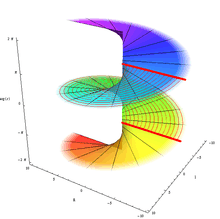
| external angle | internal angle | plain angle | |
|---|---|---|---|
| parameter plane | |||
| dynamic plane | |||
where :
- is a multiplier map
- is a Boettcher function
external
The external angle is a angle of
- point of set's exterior
- the boundary.
It is :
- the same on all points on the external ray. It is important for proving connectedness of the Mandelbrot set.
- a proper fraction
internal
The internal angle[5] is an angle of point of component's interior
- it is a rational number and proper fraction measured in turns
- it is the same for all point on the internal ray
- in a contact point ( root point ) it agrees with the rotation number
- root point has internal angle 0 ( inside child component)
- "The internal angles start at 0, at the cusp, and increase counterclockwise. " Robert Munafo[6]
plain
The plain angle is an agle of complex point = it's argument [7]
Units
- turns
- degrees
- radians
Number types
Angle ( for example external angle in turns ) can be used in different number types
Examples :
the external arguments of the rays landing at z = −0.15255 + 1.03294i are :[8]
where :
Bifurcation
- Numerical Bifurcation Analysis of Maps
- MatCont[9]
Coordinate
- Fatou coordinate for every repelling and attracting petal ( linearization of function near parabolic fixed point )
- Boettcher
- Koenigs
"The coordinates are the current location, measured on the x-y-z axis. The gradient is a direction to move from our current location" Sadid Hasan[10]
Curves
Types:
- topology:
- closed versus open
- simple versus not simple
- other properities:
- invariant
- critical
Description[11]
- plane curve = it lies in a plane.
- closed = it starts and ends at the same place.
- simple = it never crosses itself.
closed
Closed curves are curves whose ends are joined. Closed curves do not have end points.
- Simple Closed Curve : A connected curve that does not cross itself and ends at the same point where it begins. It divides the plane into exactly two regions ( Jordan curve theorem ). Examples of simple closed curves are ellipse, circle and polygons.[12]
- complex Closed Curve ( not simple = non-simple ) It divides the plane into more than two regions. Example : Lemniscates.
"non-self-intersecting continuous closed curve in plane" = "image of a continuous injective function from the circle to the plane"
Circle
Inner circle
Unit circle
Unit circle is a boundary of unit disk[13]
where coordinates of point of unit circle in exponential form are :
Critical curves
Diagrams of critical polynomials are called critical curves.[14]
These curves create skeleton of bifurcation diagram.[15] (the dark lines[16])
dendrit
- a locally connected branched curve
- "Complex 1-variable polynomials with connected Julia sets and only repelling periodic points are called dendritic."[17]
- "a dendrite is a locally connected continuum that does not contain Jordan curves." [18]
- "a locally connected continuum without subsets homeomorphic to a circle"
Escape lines
Escape line = boundary of escape time's level sets
"If the escape radius is equal to 2 the contour lines have a contact point (c= -2) and cannot be considered as equipotential lines" [19]
Invariant
Types:
- topological
- shift invariants
examples :
- curve is invariant for the map f ( evolution function ) if images of every point from the curve stay on that curve[20][21][22]
- curve is invariant for a system of ordinary differential equations[23]
"Quasi-invariant curves are used in the study of hedgehog dynamics" RICARDO PEREZ-MARCO[24]
Isocurves
Equipotential lines
Equipotential lines = Isocurves of complex potential
"If the escape radius is greater than 2 the contour lines are equipotential lines" [25]
Jordan curve
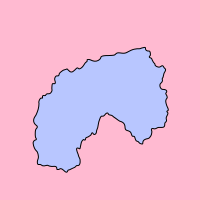
Jordan curve = a simple closed curve that divides the plane into an "interior" region bounded by the curve and an "exterior" region containing all of the nearby and far away exterior points[26]
Lamination
Lamination of the unit disk is a closed collection of chords in the unit disc, which can intersect only in an endpoint of each on the boundary circle[27][28]
It is a model of Mandelbrot or Julia set.
A lamination, L, is a union of leaves and the unit circle which satisfies :[29]
- leaves do not cross (although they may share endpoints) and
- L is a closed set.
"The pattern of rays landing together can be described by a lamination of the disk. As θ is varied, the diameter defined by θ/2 and (θ +1)/2 is moving and disconnecting or reconnecting chords. " Wolf Jung [30]
Leaf
Chords = leaves = arcs
A leaf on the unit disc is a path connecting two points on the unit circle.[31]
"In Thurston’s fundamental preprint, the two characteristic rays and their common landing point are the “minor leaf” of a “lamination”"[32]
Open curve
Curve which is not closed. Examples : line, ray.
Ray
Rays are :
- invariant curves
- dynamic or parameter
- external, internal or extended
Extended
"We prolong an external ray R θ supporting a Fatou component U (ω) up to its center ω through an internal ray and call the resulting set the extended ray E θ with argument θ." Alfredo Poirier[33]
External ray
Internal ray
Definition:
- "The internal rays are the preimages of the radial segments under the coordinate with componenet center corresponding to 0." Alfredo Poirier[34]
Internal rays are :
- dynamic ( on dynamic plane , inside filled Julia set )
- |parameter ( on parameter plane , inside Mandelbrot set ) usuning multiplier map
dynamic
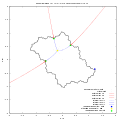 Dynamic internal ( blue segment) and external ( red ray) rays
Dynamic internal ( blue segment) and external ( red ray) rays
For a parameter c with superattracting orbit: for every Fatou component of filled julia set[35] there is:
- a unique periodic or pre-periodic point of the super-attracting orbit
- a Riemann map that maps:[36]
component to unit disc:
and point to the origin:
The point is called the center of component .
For any angle the pre-image of the radial segment of the unit disc
is called an internal ray of component with well-defined landing point.
where:
See also:
interwined
The internal rays are the curves that connects endpoints of external rays to the origin ( the only pole) by winding in the specific way through the Julia set. Unlike the external rays the internal rays allways cross other internal rays, usually at multiple points, hence they are interwined[37]
parameter

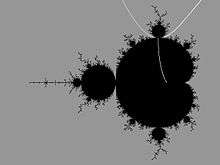 Uniformization of the interior of Mandelbrot set components using multiplier map: internal rays , internal coordinate
Uniformization of the interior of Mandelbrot set components using multiplier map: internal rays , internal coordinate Method of computing internal ray using explicit equation
Method of computing internal ray using explicit equation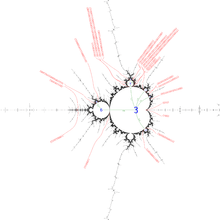 Wakes near the period 3 island in the Mandelbrot set, internal angles and rays (green) and external angles and rays (red)
Wakes near the period 3 island in the Mandelbrot set, internal angles and rays (green) and external angles and rays (red)
Escape route
Escape route is a path inside Mandelbrot set.
Escape route 1/2 <re>Plotting the Escape: An Animation of Parabolic Bifurcations in the Mandelbrot Set by Anne M. Burns. Mathematics Magazine Vol. 75, No. 2 (Apr., 2002), pp. 104-116 </ref>
- is part of the real slice of the mandelbrot set)
- part of the real line x=0
Steps:
- start from center of period 1
- go along internal ray 1/2 to root point of period 2 component
- go along internal ray 0 to the center of period 2 component
- go along internal ray 1/2 to root point of period 4 component
- ...
- escape routes
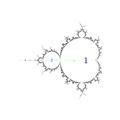 1/2
1/2 1/3
1/3
Spider
A spider S is a collection of disjoint simple curves called legs [38]( extended rays = external + internal ray) in the complex plane connecting each of the post-critical points to infnity [39]
See :
Spine
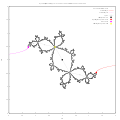 Rabbit Julia set with spine
Rabbit Julia set with spine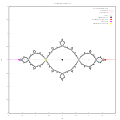 Basilica Julia set with spine
Basilica Julia set with spine
In the case of complex_quadratic_polynomial the spine of the filled Julia set is defined as arc between -fixed point and ,
with such properties:
- spine lies inside .[40] This makes sense when is connected and full [41]
- spine is invariant under 180 degree rotation,
- spine is a finite topological tree,
- Critical point always belongs to the spine.[42]
- -fixed point is a landing point of external ray of angle zero ,
- is landing point of external ray .
Algorithms for constructing the spine:
- detailed version is described by A. Douady[43]
- Simplified version of algorithm:
- connect and within by an arc,
- when has empty interior then arc is unique,
- otherwise take the shortest way that contains .[44]
Curve :
divides dynamical plane into two components.
Computing external angle for c from centers of hyperbolic components and Misiurewicz points:
The spine of K is the arc from beta to minus beta. Mark 0 each time C is above the spine and 1 each time it is below. You obtain the expansion in base 2 of the external argument theta of z by C. This simply comes from the two following facts: * 0 < theta < 1/2 if acces to z is above the spine, 1/2 < theta < 1 if it is below * function f doubles the external arguments with respect to K , as well as the potential, since Riemman map ( Booettcher map) conjugates f to . Note that if c and z are real, the tree reduces to the segment [beta',beta] of the real line, and the sequence of 0 and 1 obtained is just the kneading sequence studied by Milnor and Thurston (except for convention: they use 1 and -1). This sequence appears now as the binary expansion of a number which has a geometrical interpretation. " A. Douady
Vein
"A vein in the Mandelbrot set is a continuous, injective arc inside in the Mandelbrot set"
"The principal vein is the vein joining to the main cardioid" (Entropy, dimension and combinatorial moduli for one-dimensional dynamical systems. A dissertation by Giulio Tiozzo )
Discriminant
In algebra, the discriminant of a polynomial is a polynomial function of its coefficients, which allows deducing some properties of the roots without computing them.
Dynamics
- symbolic[45][46][47]
- complex [48][49]
- Arithmetic
- combinatorial
- local/global
- discrete/continous
- parabolic/hyperbolic/eliptic
Examples:
- discrete local complex parabolic dynamics
symbolic
"Symbolic dynamics encodes :
- a dynamical system by a shift map on a space of sequences over finite alphabet using Markov paritition of the space
- the points of space by their itineraries with respect to the paritition " ( Volodymyr Nekrashevych - Symbolic dynamics and self-similar groups
entropy
- image entropy [50]
equation
differential
differential equations
- exact analytic solutions.
- approximated solution
- use perturbation theory to approximate the solutions
Field
Field is a region in space where each and every point is associated with a value.
The field types according to the value type :
- scalar field
- vector field, for example gradient field
Function
Derivative
- Derivative of Iterated function (map)[51][52]
- of the function f with respect to variable ...
- following the derivative[53]
Derivative with respect to c
On parameter plane :
- is a variable
- is constant
This derivative can be found by iteration starting with
and then ( compute derivative before next z because it uses previous values of z):
This can be verified by using the chain rule for the derivative.
- Maxima CAS function :
dcfn(p, z, c) :=
if p=0 then 1
else 2*fn(p-1,z,c)*dcfn(p-1, z, c)+1;
Example values :
It can be used for:
- the distance estimation method for drawing a Mandelbrot set ( DEM/M )
Derivative with respect to z
is first derivative with respect to z.
This derivative can be found by iteration starting with
and then :
| description | arbitrary name | formula | Initial conditions | Recurrence step | common names |
|---|---|---|---|---|---|
| iterated complex quadratic polynomial | z or f | ||||
| first derivative with respect to z | dz, d (from derivative) or p ( from prime) of f' |
Derivation of recurrence relation:
It can be used for :
- computing the external distance to the Julia set ( DEM/J )
- detection of interior points of Mandelbrot set componnets[54]
unsigned char ComputeColorOfDEMJ(complex double z){
// https://en.wikibooks.org/wiki/Fractals/Iterations_in_the_complex_plane/Julia_set#DEM.2FJ
int nMax = iterMax;
complex double dz = 1.0; // is first derivative with respect to z.
double distance;
double cabsz;
int n;
for (n=0; n < nMax; n++){ //forward iteration
if (cabs(z)> 1e60 || cabs(dz)> 1e60) break; // big values
dz = 2.0*z * dz;
z = z*z +c ; /* forward iteration : complex quadratic polynomial */
}
cabsz = cabs(z);
distance = 2.0 * cabsz* log(cabsz)/ cabs(dz);
if (distance <distanceMax) {//printf(" distance = %f \n", distance);
return iColorOfBoundary;}
return iColorOfExterior;
}
The Schwarzian Derivative
Wirtinger derivatives
gradient
the gradient is the generalization of the derivative for the multivariable functions[59][60]
definitions:
- (field): Gradient field is the vector field with gradient vector
- (function): The gradient of a scalar-valued multivariable function is a vector-valued function denoted
- (vector): The gradient of the function f at the point (x,y) is defined as the unique vector ( result of gradient function) representing the maximum rate of increase of a scalar function ( length of the vector) and the direction of this maximal rate ( angle of the vector). Such vector is given by the partial derivatives with respect to each of the independent variables[61]
- (operator): Del or nabla is an gradient operator = a vector differential operator
 Gradient 2D field with gradient vectors
Gradient 2D field with gradient vectors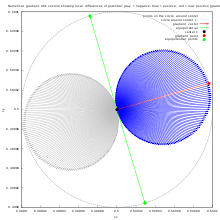 one gradient vector (red)
one gradient vector (red)
Notations:
See also
Jacobian
The Jacobian is the generalization of the gradient for vector-valued functions of several variables
Germ
Germ [64] of the function f in the neighborhood of point z is a set of the functions g which are indistinguishable in that neighborhood
See :
- parabolic germ
- the linearization of a germ[65]
map
- differences between map and the function [66]
- Iterated function = map[67]
- an evolution function[68] of the discrete nonlinear dynamical system[69]
is called map :
types or names
Brjuno
- Brjuno function
Links:
harmonic
An harmonic or spherical function is a:
- "set of orthogonal functions all of whose curvatures are changing at the same rate."[70]
- "harmonic functions relate two sets of different curves such that the rate of change of their respective curvatures is always equal. " and they are orthogonal
- "One set of curves of the harmonic function expressed the pathways of minimal change in the potential for action, while the other, orthogonal curves expressed the pathways of maximum change in the potential for action."
- "a pair of harmonic conjugate functions, u and v. They satisfy the Cauchy-Riemann equations. Geometrically, this implies that the contour lines of u and v intersect at right angles"[71]
Geometric examples:
- " A set of concentric circles and radial lines comprises an harmonic function because both the circles and the radial lines intersect orthogonally and both have constant curvature."
- "a set of orthogonal ellipses and hyperbolas."
How to find harmonic conjugate function ? [72]
meromorphic
meromorphic maps: Those with NO FINITE, NON-ATTRACTING FIXED POINTS[73]
Polynomial
Critical
Critical polynomial :
so
These polynomials are used for finding :
- centers of period n Mandelbrot set components. Centers are roots of n-th critical polynomials ( points where critical curve Qn croses x axis )
- Misiurewicz points
post-critically finite
a post-critically finite polynomial = all critical points have finite orbit
Resurgent
"resurgent functions display at each of their singular points a behaviour closely related to their behaviour at the origin. Loosely speaking, these functions resurrect, or surge up - in a slightly different guise, as it were - at their singularities"
Yoccoz’s function
glitches
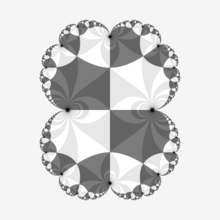
Definition:
- Incorrect parts of renders[77] using perturbation techique
- pixels which dynamics differ significantly from the dynamics of the reference pixel[78]"These can be detected and corrected by using a more appropriate reference."[79]
Examples:
graf
Dessin d'enfant
See also:
Tree
Farey tree
Farey tree = Farey sequence as a tree
Hubbard tree
- a simplified, combinatorial model of the Julia set ( MARY WILKERSON)
- "Hubbard trees are finite planar trees, equipped with self-maps, which classify postcritically finite polynomials as holomorphic dynamical systems on the complex plane." [80]
- " Hubbard trees are invariant trees connecting the points of the critical orbits of post-critically finite polynomials. Douady and Hubbard showed in the Orsay Notes that they encode all combinatorial properties of the Julia sets. For quadratic polynomials, one can describe the dynamics as a subshift on two symbols, and itinerary of the critical value is called the kneading sequence." Henk Bruin and Dierk Schleicher[81]
Rooted tree
rooted tree of preimages:
where a vertex is connected by an edge with .
Iteration
Magnitude
- magnitude of the point ( complex number in 2D case) = it's distance from the origin[82]
- radius is the absolute value of complex number ( compare to arguments or angle)
Map
types
- The map f is hyperbolic if every critical orbit converges to a periodic orbit.[83]
Complex quadratic map
Forms
c form :
- math notation :
- Maxima CAS function :
f(z,c):=z*z+c;
(%i1) z:zx+zy*%i; (%o1) %i*zy+zx (%i2) c:cx+cy*%i; (%o2) %i*cy+cx (%i3) f:z^2+c; (%o3) (%i*zy+zx)^2+%i*cy+cx (%i4) realpart(f); (%o4) -zy^2+zx^2+cx (%i5) imagpart(f); (%o5) 2*zx*zy+cy
Iterated quadratic map
- math notation
...
or with subscripts :
- Maxima CAS function :
fn(p, z, c) :=
if p=0 then z
elseif p=1 then f(z,c)
else f(fn(p-1, z, c),c);
zp:fn(p, z, c);
lambda form :
More description Maxima CAS code ( here m not lambda is used ) :
(%i2) z:zx+zy*%i; (%o2) %i*zy+zx (%i3) m:mx+my*%i; (%o3) %i*my+mx (%i4) f:m*z+z^2; (%o4) (%i*zy+zx)^2+(%i*my+mx)*(%i*zy+zx) (%i5) realpart(f); (%o5) -zy^2-my*zy+zx^2+mx*zx (%i6) imagpart(f); (%o6) 2*zx*zy+mx*zy+my*zx
Switching between forms
Start from :
- internal angle
- internal radius r
Multiplier of fixed point :
When one wants change from lambda to c :[85]
or from c to lambda :
Example values :
| r | c | fixed point alfa | fixed point | ||
|---|---|---|---|---|---|
| 1/1 | 1.0 | 0.25 | 0.5 | 1.0 | 0 |
| 1/2 | 1.0 | -0.75 | -0.5 | -1.0 | 0 |
| 1/3 | 1.0 | 0.64951905283833*i-0.125 | 0.43301270189222*i-0.25 | 0.86602540378444*i-0.5 | 0 |
| 1/4 | 1.0 | 0.5*i+0.25 | 0.5*i | i | 0 |
| 1/5 | 1.0 | 0.32858194507446*i+0.35676274578121 | 0.47552825814758*i+0.15450849718747 | 0.95105651629515*i+0.30901699437495 | 0 |
| 1/6 | 1.0 | 0.21650635094611*i+0.375 | 0.43301270189222*i+0.25 | 0.86602540378444*i+0.5 | 0 |
| 1/7 | 1.0 | 0.14718376318856*i+0.36737513441845 | 0.39091574123401*i+0.31174490092937 | 0.78183148246803*i+0.62348980185873 | 0 |
| 1/8 | 1.0 | 0.10355339059327*i+0.35355339059327 | 0.35355339059327*i+0.35355339059327 | 0.70710678118655*i+0.70710678118655 | 0 |
| 1/9 | 1.0 | 0.075191866590218*i+0.33961017714276 | 0.32139380484327*i+0.38302222155949 | 0.64278760968654*i+0.76604444311898 | 0 |
| 1/10 | 1.0 | 0.056128497072448*i+0.32725424859374 | 0.29389262614624*i+0.40450849718747 | 0.58778525229247*i+0.80901699437495 |
One can easily compute parameter c as a point c inside main cardioid of Mandelbrot set :
of period 1 hyperbolic component ( main cardioid) for given internal angle ( rotation number) t using this c / cpp code by Wolf Jung[86]
double InternalAngleInTurns;
double InternalRadius;
double t = InternalAngleInTurns *2*M_PI; // from turns to radians
double R2 = InternalRadius * InternalRadius;
double Cx, Cy; /* C = Cx+Cy*i */
// main cardioid
Cx = (cos(t)*InternalRadius)/2-(cos(2*t)*R2)/4;
Cy = (sin(t)*InternalRadius)/2-(sin(2*t)*R2)/4;
or this Maxima CAS code :
/* conformal map from circle to cardioid ( boundary
of period 1 component of Mandelbrot set */
F(w):=w/2-w*w/4;
/*
circle D={w:abs(w)=1 } where w=l(t,r)
t is angle in turns ; 1 turn = 360 degree = 2*Pi radians
r is a radius
*/
ToCircle(t,r):=r*%e^(%i*t*2*%pi);
GiveC(angle,radius):=
(
[w],
/* point of unit circle w:l(internalAngle,internalRadius); */
w:ToCircle(angle,radius), /* point of circle */
float(rectform(F(w))) /* point on boundary of period 1 component of Mandelbrot set */
)$
compile(all)$
/* ---------- global constants & var ---------------------------*/
Numerator :1;
DenominatorMax :10;
InternalRadius:1;
/* --------- main -------------- */
for Denominator:1 thru DenominatorMax step 1 do
(
InternalAngle: Numerator/Denominator,
c: GiveC(InternalAngle,InternalRadius),
display(Denominator),
display(c),
/* compute fixed point */
alfa:float(rectform((1-sqrt(1-4*c))/2)), /* alfa fixed point */
display(alfa)
)$
Circle map
Circle map [87]
- irrational rotation[88]
Doubling map
C function ( using GMP library) :
// rop = (2*op ) mod 1
void mpq_doubling(mpq_t rop, const mpq_t op)
{
mpz_t n; // numerator
mpz_t d; // denominator
mpz_inits(n, d, NULL);
//
mpq_get_num (n, op); //
mpq_get_den (d, op);
// n = (n * 2 ) % d
mpz_mul_ui(n, n, 2);
mpz_mod( n, n, d);
// output
mpq_set_num(rop, n);
mpq_set_den(rop, d);
mpz_clears(n, d, NULL);
}
- Maxima CAS function using numerator and denominator as an input
doubling_map(n,d):=mod(2*n,d)/d $
or using rational number as an input
DoublingMap(r):=
block([d,n],
n:ratnumer(r),
d:ratdenom(r),
mod(2*n,d)/d)$
- Common Lisp function
(defun doubling-map (ratio-angle)
" period doubling map = The dyadic transformation (also known as the dyadic map,
bit shift map, 2x mod 1 map, Bernoulli map, doubling map or sawtooth map "
(let* ((n (numerator ratio-angle))
(d (denominator ratio-angle)))
(setq n (mod (* n 2) d)) ; (2 * n) modulo d
(/ n d))) ; result = n/d
- Haskell function[92]
-- by Claude Heiland-Allen
-- type Q = Rational
double :: Q -> Q
double p
| q >= 1 = q - 1
| otherwise = q
where q = 2 * p
- C++
// mndcombi.cpp by Wolf Jung (C) 2010.
// http://mndynamics.com/indexp.html
// n is a numerator
// d is a denominator
// f = n/d is a rational fraction ( angle in turns )
// twice is doubling map = (2*f) mod 1
// n and d are changed ( Arguments passed to function by reference)
void twice(unsigned long long int &n, unsigned long long int &d)
{ if (n >= d) return;
if (!(d & 1)) { d >>= 1; if (n >= d) n -= d; return; }
unsigned long long int large = 1LL;
large <<= 63; //avoid overflow:
if (n < large) { n <<= 1; if (n >= d) n -= d; return; }
n -= large;
n <<= 1;
large -= (d - large);
n += large;
}
Inverse function of doubling map
Every angle α ∈ R/Z measured in turns has :
- one image = 2α mod 1 under doubling map
- "two preimages under the doubling map: α/2 and (α + 1)/2.".[93] Inverse of doubling map is multivalued function.
In Maxima CAS :
InvDoublingMap(r):= [r/2, (r+1)/2];
Note that difference between these 2 preimages
is half a turn = 180 degrees = Pi radians.
Feigenbaum map
"the Feigenbaum map F is a solution of Cvitanovic-Feigenbaum equation"[94]
First return map
- definition [95]
- video : Intro to Poincare map (Poincaré), the first return map. This map helps us determine the stability of a limit cycle using the eigenvalues (Floquet multipliers) associated with the map.
"In contrast to a phase portrait, the return map is a discrete description of the underlying dynamics. .... A return map (plot) is generated by plotting one return value of the time series against the previous one "[96]
"If x is a periodic point of period p for f and U is a neighborhood of x, the composition maps U to another neighborhood V of x. This locally defined map is the return map for x." ( W P Thurston : On the geometry and dynamics of Iterated rational maps)
"The first return map S → S is the map defined by sending each x0 ∈ S to the point of S where the orbit of x0 under the system first returns to S." [97]
"way to obtain a discrete time system from a continuous time system, called the method of Poincar´e sections Poincar´e sections take us from : continuous time dynamical systems on (n + 1)-dimensional spaces to discrete time dynamical systems on n-dimensional spaces"[98]
postcritically finite
postcritically finite: maps whose critical orbits are all periodic or preperiodic[99]
" In the theory of iterated rational maps, the easiest maps to understand are postcritically finite: maps whose critical orbits are all periodic or preperiodic. These maps are also the most important maps for understanding the combinatorial structure of parameter spaces of rational maps. "
A postcritically finite quadratic polynomial fc(z) = z^2+c may be:[100]
- periodic of satellite type
- periodic of primitive type
- critically preperiodic (Misiurewicz type)
Examples are given by:
- the Basilica Q(z) = z^2 − 1
- the Kokopelli (
- P(z) = z^2 + i ( dendrite)
Critically preperiodic polynomials
- the critical point of fc is strictly preperiodic
- parameter c is from Thurston-Misiurewicz points–values on the boundary of the Mandelbrot set = Misiurewicz point
- Julia set is dendrite
Multiplier map

Multiplier map associated with hyperbolic component
- gives an explicit uniformization of hyperbolic component by the unit disk :
In other words it maps hyperbolic component H to unit disk D.
It maps point c from parameter plane to point b from reference plane:
where:
- c is a point in the parameter plane
- b is a point in the reference plane. It is also internal coordinate
- is a multiplier map
Multiplier map is a conformal isomorphism.[101]
It can be computed using :
Riemann map
Riemann mapping theorem[102] says that every simply connected subset U of the complex number plane can be mapped to the open unit disk D
where:
- D is a unit disk
- f is Riemann map ( function)
- U is subset of complex plane
Examples
- multiplier map on the parameter plane
- Böttcher coordinates
- on the parameter plane the Riemann map for the complement of the Mandelbrot set
- on dynamic plane[103]
- for the Fatou component containing a superattracting fixed point for a rational map[104]
- a Riemann map for the complement of the filled Julia set of a quadratic polynomial with connected Julia : "The Riemann map for the central component for the Basilica was drawn in essentially the same way, except that instead of starting with points on a big circle, I started with sample points on a circle of small radius (e.g. 0.00001) around the origin." Jim Belk
function:
- explicit formula ( only in simple cases)
- numerical aproximation ( in most of the cases)[105]
- Zipper
- " Thurston and others have done some beautiful work involving approximating arbitrary Riemann maps using circle packings. See Circle Packing: A Mathematical Tale by Stephenson."
- " To some extent, constructing a Riemann map is simply a matter of constructing a harmonic function on a given domain (as well as the associated harmonic conjugate), subject to certain boundary conditions. The solution to such problems is a huge topic of research in the study of PDE's, although the connection with Riemann maps is rarely mentioned." Jim Belk[106]
PDE's approach to construct a Riemann map explicitly on a given domain D
- First, translate the domain so that it contains the origin.
- Next, use a numerical method to construct a harmonic function F satisfying
for all , and let
Then
- and is harmonic
so:
- R is the radial component (i.e. modulus) of a Riemann map on D.
- The angular component can now be determined by the fact that its level curves are perpendicular to the level curves of R, and have equal angular spacing near the origin."
Rotation map
"If a is rational, then every point is periodic. If a is irrational, then every point has a dense orbit." David Richeson[107]
rational
Rotation map describes counterclockwise rotation of point thru turns on the unit circle :
It is used for computing :
- rotation maps
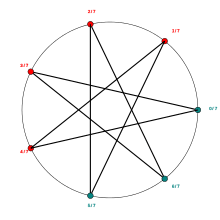
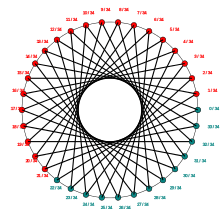
irrational
Shift map
names :
- bit shift map ( because it shifts the bit ) = if the value of an iterate is written in binary notation, the next iterate is obtained by shifting the binary point one bit to the right, and if the bit to the left of the new binary point is a "one", replacing it with a zero.
- 2x mod 1 map ( because it is math description of it's action )
Shift map (one-sided binary left shift ) acts on one-sided infinite sequence of binary numbers by
It just drops first digit of the sequence.
If we treat sequence as a binary fraction :
then shift map = the dyadic transformation = dyadic map = bit shift map= 2x mod 1 map = Bernoulli map = doubling map = sawtooth map
and "shifting N places left is the same as multiplying by 2 to the power N (written as 2N)"[108] ( operator << )
In Haskell:
shift k = genericTake q . genericDrop k . cycle -- shift map
See also:
Multiplier
Multiplier of periodic z-point :[109][110]
- "The value of is the same at any point in the orbit of a: it is called the multiplier of the cycle."[111]
Math notation :
Maxima CAS function for computing multiplier of periodic cycle :
m(p):=diff(fn(p,z,c),z,1);
where p is a period. It takes period as an input, not z point.
| period | ||
|---|---|---|
| 1 | ||
| 2 | ||
| 3 |
It is used to :
- compute stability index of periodic orbit ( periodic point) = ( where r is a n internal radius
- multiplier map
" The multiplier of a fixed point gives information about its stability (the behaviour of nearby orbits )" [112]
Number
complex number
- numerical value : x+y*i
- vector from origin to point ( x,y)
- point (x,y) od 2D Cartesion plain
constant
Fegenbaum constant
- first ( delta)[113]
- second ( alpha)
How to compute:
Rotation number
The rotation number[114][115][116][117][118] of the disk ( component) attached to the main cardioid of the Mandelbrot set is a proper, positive rational number p/q in lowest terms where :
- q is a period of attached disk ( child period ) = the period of the attractive cycles of the Julia sets in the attached disk
- p descibes fc action on the cycle : fc turns clockwise around z0 jumping, in each iteration, p points of the cycle [119]
Features :
- in a contact point ( root point ) it agrees with the internal angle
- the rotation numbers are ordered clockwise along the boundary of the componant
- " For parameters c in the p/q-limb, the filled Julia set Kc has q components at the fixed point αc . These are permuted cyclically by the quadratic polynomial fc(z), going p steps counterclockwise " Wolf Jung
Winding number
- of the map ( iterated function)[120][121]
- "the winding number of the dynamic ray at angle a around the critical value, which is defined as follows: denoting the point on the dynamic a-ray at potential t greater or equal to zero by zt and decreasing t from +infinity to 0, the winding number is the total change of arg(zt - c) (divided by 2*Pi so as to count in full turns). Provided that the critical value is not on the dynamic ray or at its landing point, the winding number is well-defined and finite and depends continuously on the parameter. " DIERK SCHLEICHER [122]
- of the curve [123][124]
Computing winding number of the curve ( which is not crossing the origin ) using:
- numerical integration
- computational geometry
The discrete winding number = winding number of polygon aproximating curve
Orbit
Orbit is a sequence of points[127]
- phase space trajectories of dynamical systems
- The orbit of periodic point is finite and it is called a cycle.
Backward
Critical
Forward orbit[128] of a critical point[129][130] is called a critical orbit. Critical orbits are very important because every attracting periodic orbit[131] attracts a critical point, so studying the critical orbits helps us understand the dynamics in the Fatou set.[132][133] [134]
This orbit falls into an attracting periodic cycle.
Code :
"https://github.com/conanite/rainbow/blob/master/src/arc/rainbow/spiral.arc
This software is copyright (c) Conan Dalton 2008. Permission to use it is granted under the Perl Foundations's Artistic License 2.0.
This software includes software that is copyright (c) Paul Graham and Robert Morris, distributed under the Perl Foundations's Artistic License 2.0.
This software uses javacc which is copyright (c) its authors
"
(def plot (plt c)
(with (z 0+0i
n 0
repeats 0)
(while (and (small z) (< n 10000) (< repeats 1000))
(assign n (+ n 1)
z (+ c (* z z))
repeats (if (apply plt (complex-parts z))
(+ repeats 1)
0)))))
Here are images:
- images of critical orbitsat commons
- by Mike Croucher[135]
- Chris King [136]
- Kerry Mitchel: cardioid-boundary-orbits
- Visualizing Escape Paths in the Mandelbrot Set by Anne M. Burns
- list:
- programs
- Geogebra ( interactive)
See also:
Forward
Homoclinic / heteroclinic
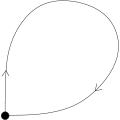 homoclinic orbit
homoclinic orbit Heteroclinic orbit
Heteroclinic orbit
Inverse
Inverse = Backward
periodic
skipped
- set containing first n iterations of initial point without initial point and its k iterations
- number of elements = n - k
It is used in the average colorings
truncated
- set containing initial point and first n iterations of initial point
- number of elements = n+1
Parameter
Parameter
- point of the parameter plane " is renormalizable if restriction of some of its iterate gives a polinomial-like map of the same or lower degree. " [139]
- parameter of the function
Period
Period of point under the iterarted function f is the smallest positive integer value p for which this equality
holds is the period[140] of the orbit.[141]
is a point of periodic orbit ( limit cycle ) .
More is here
Plane
Planes [142]
Douady’s principle : “sow in dynamical plane and reap in parameter space”.
paritition
Examples:
- Markow
- Yoccoz puzzle
Kneading paritition of the dynamic plane
In case of critically preperiodic polynomials the partition of the dynamic plane used in the definition of the kneading sequence.
Partition is formed by the dynamic rays at angles:
- t/2
- (t + 1)/2
which land together at the critical point.
Angle t is angle which lands on the critical value:
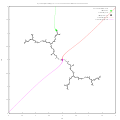 t = 1/4 preperiod = 2 period = 1
t = 1/4 preperiod = 2 period = 1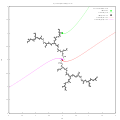 t = 1/6 preperiod = 1 and period = 2
t = 1/6 preperiod = 1 and period = 2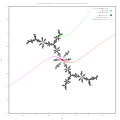 t = 9/56 preperiod = 3 and period = 3
t = 9/56 preperiod = 3 and period = 3
Spine paritition of the dynamic plane
Curve :
where:
- R is an dynamic external ray
- S is the spine of Julia set
divides dynamical plane into two components.
 Plane paritition in case of Rabbit Julia set
Plane paritition in case of Rabbit Julia set Plane paritition in case of Basilica Julia set
Plane paritition in case of Basilica Julia set
crossing/noncrossing
noncrossing: "A partition of a (finite) set is just a subdivision of the set into disjoint subsets. If the set is represented as points on a line (or around the edge of a disc), we can represent the partition with lines connecting the dots. The lines usually have lots of crossings. When the partition diagram has no crossing lines, it is called a non-crossing partition. ... They have a lot of beautiful algebraic structure, and are related to lots of old enumeration problems. More recently (and importantly), they turn out to be a crucial tool in understanding how the eigenvalues of large random matrices behave." Todd Kemp (UCSD)[143]
Key words:
- Enumerative combinatorics
types
- slit plane = plane with the slit deleted[144] : Let S be the "slit plane"
- chessboard or checkerboards
types in case of discrete dynamical system
Dynamic plane
- z-plane for fc(z)= z^2 + c
- z-plane for fm(z)= z^2 + m*z
Parameter plane
See :[145]
Types of the parameter plane :
- c-plane ( standard plane )
- exponential plane ( map) [146][147]
- flatten' the cardiod ( unroll ) [148][149] = "A region along the cardioid is continuously blown up and stretched out, so that the respective segment of the cardioid becomes a line segment. .." ( Figure 4.22 on pages 204-205 of The Science Of Fractal Images)[150]
- transformations [151]
 c-plane
c-plane inverted c plane = 1/c plane
inverted c plane = 1/c plane unrolled
unrolled
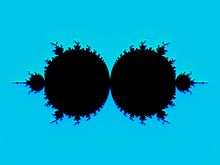 lambda plane
lambda plane
Points
Band-merging
the band-merging points are Misiurewicz points[152]
Biaccessible
If there exist two distinct external rays landing at point we say that it is a biaccessible point.[153]
Buried
" a point of the Julia set is buried if it is not in the boundary of any Fatou component." [154]
polynomials do not have buried points
some rational Julia sets have ( Residual Julia Set = Buried Points )
Center
Nucleus or center of hyperbolic component
A center of a hyperbolic component H is a parameter ( or point of parameter plane ) such that the corresponding periodic orbit has multiplier= 0." [155]
Synonyms :
- Nucleus of a Mu-Atom [156]
Center of Siegel Disc
Center of Siegel disc is a irrationally indifferent periodic point.
Mane's theorem :
"... appart from its center, a Siegel disk cannot contain any periodic point, critical point, nor any iterated preimage of a critical or periodic point. On the other hand it can contain an iterated image of a critical point." [157]
Critical
A critical point[158] of is a point in the dynamical plane such that the derivative vanishes:
Since
implies
we see that the only (finite) critical point of is the point .
is an initial point for Mandelbrot set iteration.[159]
A critical value is an image of critical point
Cut
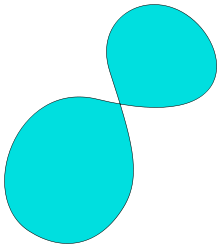
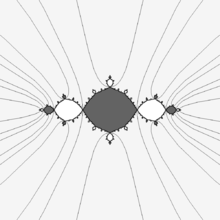
Cut point k of set S is a point for which set S-k is dissconected ( consist of 2 or more sets).[160] This name is used in a topology.
Examples :
- root points of Mandelbrot set
- Misiurewicz points of boundary of Mandelbrot set
- cut points of Julia sets ( in case of Siegel disc critical point is a cut point )
These points are landing points of 2 or more external rays.
Point which is a landing point of 2 external rays is called biaccesible
Cut ray is a ray which converges to landing point of another ray.[161] Cut rays can be used to construct puzzles.
Cut angle is an angle of cut ray.
fixed
Periodic point when period = 1
Feigenbaum
 Zoom toward Feigenbaum point
Zoom toward Feigenbaum point The Feigenbaum point (red arrow) is limit of the bifurcation point
The Feigenbaum point (red arrow) is limit of the bifurcation point
The Feigenbaum Point[162] is a :
- point c of parameter plane
- is the limit of the period doubling cascade of bifurcations
- an infinitely renormalizable parameter of bounded type
- boundary point between chaotic ( -2 < c < MF ) and periodic region ( MF< c < 1/4)[163]
Generalized Feigenbaum points are :
- the limit of the period-q cascade of bifurcations
- landing points of parameter ray or rays with irrational angles
Examples :
- -.1528+1.0397i)
The Mandelbrot set is conjectured to be self- similar around generalized Feigenbaum points[164] when the magnification increases by 4.6692 (the Feigenbaum Constant) and period is doubled each time[165]
n Period = 2^n Bifurcation parameter = cn Ratio 1 2 -0.75 N/A 2 4 -1.25 N/A 3 8 -1.3680989 4.2337 4 16 -1.3940462 4.5515 5 32 -1.3996312 4.6458 6 64 -1.4008287 4.6639 7 128 -1.4010853 4.6682 8 256 -1.4011402 4.6689 9 512 -1.401151982029 10 1024 -1.401154502237 infinity -1.4011551890 ...
Bifurcation parameter is a root point of period = 2^n component. This series converges to the Feigenbaum point c = −1.401155
The ratio in the last column converges to the first Feigenbaum constant.
" a "Feigenbaum point" (an infinitely renormalizable parameter of bounded type, such as the famous Feigenbaum value which is the limit of the period-2 cascade of bifurcations), then Milnor's hairiness conjecture, proved by Lyubich, states that rescalings of the Mandelbrot set converge to the entire complex plane. So there is certainly a lot of thickness near such a point, although again this may not be what you are looking for. It may also prove computationally intensive to produce accurate pictures near such points, because the usual algorithms will end up doing the maximum number of iterations for almost all points in the picture." Lasse Rempe-Gillen[166]
Fibonacci
infinity
The point at infinity [170]" is a superattracting fixed point, but more importantly its immediate basin of attraction - that is, the component of the basin containing the fixed point itself - is completely invariant (invariant under forward and backwards iteration). This is the case for all polynomials (of degree at least two), and is one of the reasons that studying polynomials is easier than studying general rational maps (where e.g. the Julia set - where the dynamics is chaotic - may in fact be the whole Riemann sphere). The basin of infinity supports foliations into "external rays" and "equipotentials", and this allows one to study the Julia set. This idea was introduced by Douady and Hubbard, and is the basis of the famous "Yoccoz puzzle"." Lasse Rempe-Gillen[171]
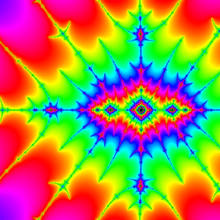
Misiurewicz
Misiurewicz point[172] = " parameters where the critical orbit is pre-periodic.
Myrberg-Feigenbaum
MF = the Myrberg-Feigenbaum point is the different name for the Feigenbaum Point.
Parabolic point
parabolic points : this occurs when two singular points coallesce in a double singular point (parabolic point)[173]
"the characteristic parabolic point (i.e. the parabolic periodic point on the boundary of the critical value Fatou component) of fc"[174]
Periodic
Point z has period p under f if :
In other words point is periodic
See also:
- fixed point
- stability of periodic point
- attracting
- repelling
- indifferent
- multiplier of periodic cycle
Pinching
"Pinching points are found as the common landing points of external rays, with exactly one ray landing between two consecutive branches. They are used to cut M or K into well-defined components, and to build topological models for these sets in a combinatorial way. " ( definition from Wolf Jung program Mandel )
other names
- pinch points
- cut points
See for examples :
- period 2 = Mandel, demo 2 page 3.
- period 3 = Mandel, demo 2 page 5 [175]
Pool
"A point in the dendrite is called a pool if it is the landing point for two external rays, both of whose angles are of the form
for some k, n ∈ N, where k ≡ 1 mod 6.
...
central pool ... it is geometrically the center of the dendrite; a one half rotation around this point maps the dendrite to itself." [176]
post-critical
A post-critical point is a point
where is a critical point.[177]
precritical
precritical points, i.e., the preimages of the critical point
reference point
Reference point of the image:
- its orbit ( reference orbit) is computed with arbitrary precision and saved
- orbits of the other points of the image ( no-reference points) are computed from reference orbit using standard precision ( with hardware floating point numbers ) = faster then using arbitrary precision
renormalizable
point of the parameter plane " is renormalizable if restriction of some of its iterate gives a polinomial-like map of the same or lower degree. " [178]
infinitely renormalizable
" a "Feigenbaum point" (an infinitely renormalizable parameter of bounded type, such as the famous Feigenbaum value which is the limit of the period-2 cascade of bifurcations), then Milnor's hairiness conjecture, proved by Lyubich, states that rescalings of the Mandelbrot set converge to the entire complex plane. So there is certainly a lot of thickness near such a point, although again this may not be what you are looking for. It may also prove computationally intensive to produce accurate pictures near such points, because the usual algorithms will end up doing the maximum number of iterations for almost all points in the picture." Lasse Rempe-Gillen[179]
root or bond
The root point of the hyperbolic componnet of the Mandelbrot set :
- A point where two mu-atoms meet
- has a rotational number 0
- it is a biaccesible point ( landing point of 2 external rays )
Names:
- bond [180]
singular
the singular points of a dynamical system
In complex analysis there are four classes of singularities:
- Isolated singularities: Suppose the function f is not defined at a, although it does have values defined on U \ {a}.
- The point a is a removable singularity of f if there exists a holomorphic function g defined on all of U such that f(z) = g(z) for all z in U \ {a}. The function g is a continuous replacement for the function f.
- The point a is a pole or non-essential singularity of f if there exists a holomorphic function g defined on U with g(a) nonzero, and a natural number n such that f(z) = g(z) / (z − a)n for all z in U \ {a}. The least such number n is called the order of the pole. The derivative at a non-essential singularity itself has a non-essential singularity, with n increased by 1 (except if n is 0 so that the singularity is removable).
- The point a is an essential singularity of f if it is neither a removable singularity nor a pole. The point a is an essential singularity if and only if the Laurent series has infinitely many powers of negative degree.
- Branch points are generally the result of a multi-valued function, such as or being defined within a certain limited domain so that the function can be made single-valued within the domain. The cut is a line or curve excluded from the domain to introduce a technical separation between discontinuous values of the function. When the cut is genuinely required, the function will have distinctly different values on each side of the branch cut. The shape of the branch cut is a matter of choice, however, it must connect two different branch points (like and for ) which are fixed in place.
triple
"A point in the dendrite is called a triple point if its removal separates the dendrite into three connected components. Such a point is the landing point for three external rays, whose angles all have of the form
for some k, n ∈ N, where k is congruent to 1, 2 or 4, mod 7." Will Smith in Thompson-Like Groups for Dendrite Julia Sets
Portrait
orbit portrait
types
There are two types of orbit portraits: primitive and satellite.[181] If is the valence of an orbit portrait and is the recurrent ray period, then these two types may be characterized as follows:
- Primitive orbit portraits have and . Every ray in the portrait is mapped to itself by . Each is a pair of angles, each in a distinct orbit of the doubling map. In this case, is the base point of a baby Mandelbrot set in parameter space.
- Satellite ( non-primitive ) orbit portraits have . In this case, all of the angles make up a single orbit under the doubling map. Additionally, is the base point of a parabolic bifurcation in parameter space.
Critical
Critical orbit portrait = portrait of the critical orbit
- ... for the polynomial we may note the critical orbit portrait:
for this map, or we may double the angles of external rays and record the locations of landing points in order to observe the same behavior." [182]
Precision
Precision of :
- data type used for computation. Measured in bits (width of significant ( fraction) = number of binary digits) or in decimal digits
- input values
- result ( number of significant figures )
See :
- Numerical Precision : " Precision is the number of digits in a number. Scale is the number of digits to the right of the decimal point in a number. For example, the number 123.45 has a precision of 5 and a scale of 2."[183]
- error [184]
Principle
Douady’s principle
Douady’s principle : “sow in dynamical plane and reap in parameter space”.
Problem
small divisor problem
Types
- One-Dimensional Small Divisor Problems[185] (On Holomorphic Germs and Circle Diffeomorphisms)
Where it can be found:
- stability in mechanics, particularly in celestial mechanics
- relations between the growth of the entries in the continued fraction expansion of t and the behaviour of f around z=0 under iteration.
See:
Processes or transformations and phenomenona
Aliasing and antialising
Contraction and dilatation
- the contraction z → z/2
- the dilatation z → 2z.
differentiation
Method of computing the derivative of a mathematical function
types:
Discretizations
Implosion and explosion
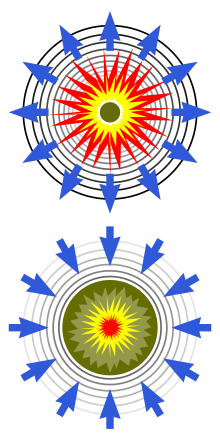
Implosion is :
- the process of sudden change of quality fuatures of the object, like collapsing (or being squeezed in)
- the opposite of explosion
Example :
- parabolic implosion in complex dynamics ( )
- when filled Julia for complex quadratic polynomial set looses all its interior ( when c goes from 0 along internal ray 0 thru parabolic point c=1/4 and along extrnal ray 0 = when c goes from interior , crosses the bounday to the exterior of Mandelbrot set)[193]
- " We can see that looks somewhat like from the "outside", but on the "inside" there are curlicues; pairs of them are vaguely reminiscent of "butterflies". As t→0, these butterflies persist and remain uniformly large. We think of t as representing time, which decreases to 0. The fact that they suddenly disappear for t=0 is the phenomenon called "implosion". Or, if we think of time starting at t=0, then the instantaneous appearance of large "butterflies" for t>0 may be thought of as "explosion". "
- Semi-parabolic implosion in [194]
Explosion is a :
- sudden change of quality fuatures of the object in an extreme manner,
- the opposite of implosion
Example : in exponential dynamics when λ> 1/e , the Julia set of is the entire plane.[195]
Linearization
- changing from non-linear to linear
- " ... turn the perturbated linear map into the exactly linear map ( it linearizes )" Jean-Christophe Yoccoz[196]
- linearization in english wikipedia
- Linearization in scholarpedia
- "System is linearizable at the origin if and only if there exists a change of coordinates which linearizes the system, that is, all the coefficients of the normal form vanish." [197]
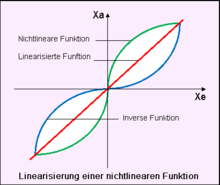
Mating
Mating [198]
Normalization
Normalize
- normalize = transformation to the model[199]
- " normalize this vector so it has modulus one " A Cheritat
- move fixed point to the origin ( z= 0 )
- mapping the range of variable to standard range
- [0.0, 1.0]
- [0,255], like rgb values
- converting closed curve to unit circle
- converting closed curves to concentric circles with center at the origin[200]
See also:
- uniformization
- renormalization
Parametrization
- Parametrization is the process of finding parametric equations of a curve[201]
Perturbation
- Perturbation technque for fast rendering the deep zoom images of the Mandelbrot set[202]
- perturbation of parabolic point [203]
- use perturbation theory to approximate the solutions of the differential equations
- perturbation of point x : where epsilon is absolute value of aproximation error[204]
Renormalization
"to any quadratic map f we can associate a canonical sequence of periods p1 < p2 <... for which f is renormalizable.
Depending on whether the sequence is:
- empty
- finite
- infinite
the map f is called respectively:
- non-renormalizable
- at most finitely renormalizable
- infinitely renormalizable" [205]
"Sectorial renormalizations are useful in the nonlinearizable situation. " Ricardo Pérez-Marco[206]
Surgery
 Surgery on the circle
Surgery on the circle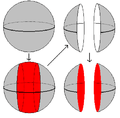 Surgery on the sphere
Surgery on the sphere
Links:
Tuning
Uniformization
Vectorisation
property or feature
Density
density of the image
- downsaling with gamma correction[213]
- path finding[214]
- supersampling: "ots of detail but fractal fades away as you get more accurate, as n increases in nxn supersampling" TGlad
Hyperbolic/parabolic/eliptic
The meaning of the terms "elliptic, hyperbolic, parabolic" in different disciplines in mathematics[215]
- PDE ( Linear Second Order PDE’s in two Independent Variables) :
- Moebius transformations :
- dicrete local complex dynamics
- Conic section
- Quadratic form
- probability distributions.
Invariant
sth is invariant with respect to the transformation = non modified, steady
Topological methods for the analysis of dynamical systems
Invariants type
- metric invariants
- dynamical invariants,
- topological invariants.
dynamical
Dynamical invariants = invariants of the dynamical system
- periodic points
- fixed point
- invariant curve
- periodic ray
- external
- internal
- periodic ray
Dynamical Invariants Derived from Recurrence Plots[216]
smooth
smooth = changing without visible (noticeable) edges
use:
- smooth gradient
similar:
- conitnuous
compare:
- discrete
Stability
- stability of quasiperiodic motion under small perturbation. In the celestial mechanics dynamics of 3 bodies around sun is described by the system of differential equations. In such case it "becomes fantastically complicated and remains largely mysterious even today." See KAM = Kolmogorov–Arnold–Moser theorem and small divisor problem
- stability of the fixed point under small perturbation
- there is equivalence (for |f′(0)| ≤ 1) of stability (a topological notion) and linearizability (an analytical notion)
Compare with:
- shadowing lemma
- Sensitive dependence on initial conditions - Butterfly effect
Radius
Radius of complex number
The absolute value or modulus or magnitude or radius of a complex number
Conformal radius
Conformal radius of Siegel Disk [217][218]
Escape radius ( ER)
Escape radius ( ER ) or bailout value is a radius of circle centered at origin ( z=0). This set is used as a target set in the bailout test ( escape time method = ETM )
Minimal Escape Radius should be grater or equal to 2 :
Better estimation is :[219][220]
Inner radius
Inner radius of Siegel Disc
- radius of inner circle, where inner circle with center at fixed point is the biggest circle inside Siegel Disc.
- minimal distance between center of Siel Disc and critical orbit
Internal radius
Internal radius is a:
- absolute value of multiplier
See also : the N-2 rule[221]
Sequences
A sequence is an ordered list of objects (or events).[222]
A series is the sum of the terms of a sequence of numbers.[223] Some times these names are not used as in above definitions.
Itinerary
is an itinerary of point x under the map f relative to the paritirtion.
It is a right-infinite sequence of zeros and ones [224]
where
Examples :
For rotation map and invariant interval ( circle ) :
one can compute :
and split interval into 2 subintervals ( lower circle paritition):
then compute s according to it's relation with critical point :
Itinerary can be converted[225] to point
kneading sequence
- "the kneading sequence of an external angle ϑ (here ϑ = 1/6) is defined as the itinerary of the orbit of ϑ under angle doubling, where the itinerary is taken with respect to the partition formed by the angles ϑ/2, and (ϑ + 1)/2 "[226]
- The itinerary ν = ν1ν2ν3 . . . of the critical value is called the kneading sequence.[227] One can start from the critical point but neglect the initial symbol. Such sequence is computed with the Hubbard tree
- Paritition of dynamic plane
 t = 1/6 preperiod = 1 and period = 2
t = 1/6 preperiod = 1 and period = 2 t = 9/56 preperiod = 3 and period = 3
t = 9/56 preperiod = 3 and period = 3
Thue–Morse sequence
Thue–Morse sequence
- how to compute it[228]
Orbit
Orbit can be:
Series
A series is the sum of the terms of a sequence of numbers.[229] Some times these names are not used as in above definitions.
Taylor
Set
Continuum
definition[232]
Component
connected component (blob) in the image
Components of parameter plane
Names:
Islands
Names :
- mini Mandelbrot set
- 'baby'-Mandelbrot set
- island mu-molecules = embedded copy of the Mandelbrot Set[235]
- Bug
- Island
- Mandelbrotie
- Midget
List of islands :
- http://mrob.com/pub/mu-data/largest-islands.txt
- http://mrob.com/pub/muency/largestislands.html
- http://www.math.cornell.edu/~rperez/Documents/maximals.pdf
- http://fraktal.republika.pl/mset_external_ray_mini.html
- http://mathr.co.uk/mandelbrot/feature-database.csv.bz2 ( a database of all islands up to period 16, found by tracing external rays): period, islandhood, angled internal address, lower external angle numerator, denominator, upper numerator, denominator, orientation, size, centre realpart, imagpart
Primitive and satellite
"Hyperbolic components come in two kinds, primitive and satellite, depending on the local properties of their roots." [236]
- primitive ( non-satellite)
- satellite
point
primare
Child (Descendant ) and the parent ( ancestor)
- ancestor of hyperbolic componnet
- descendant of hyperbolic component = child [241]
Hyperbolic component of Mandelbrot set
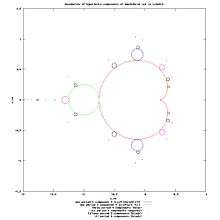
Domain is an open connected subset of a complex plane.
"A hyperbolic component H of Mandelbrot set is a maximal domain (of parameter plane) on which has an attracting periodic orbit.
A center of a H is a parameter ( or point of parameter plane ) such that the corresponding periodic orbit has multiplier= 0." [242]
A hyperbolic component is narrow if it contains no component of equal or lesser period in its wake [243]
features of hyperbolic component
- period
- islandhood ( shape = cardiod or circle )
- angled internal address
- lower and upper external angle of rays landing on it's root
- center (
- root
- orientation
- size
Limb
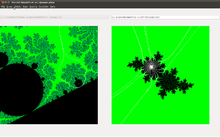
p/q-limb is a part of Mandelbrot set contained inside p/q-wake
For every rational number , where p and q are relatively prime, a hyperbolic component of period q bifurcates from the main cardioid. The part of the Mandelbrot set connected to the main cardioid at this bifurcation point is called the p/q-limb. Computer experiments suggest that the diameter of the limb tends to zero like . The best current estimate known is the Yoccoz-inequality, which states that the size tends to zero like .
A period-q limb will have q − 1 "antennae" at the top of its limb. We can thus determine the period of a given bulb by counting these antennas.
In an attempt to demonstrate that the thickness of the p/q-limb is zero, David Boll carried out a computer experiment in 1991, where he computed the number of iterations required for the series to converge for z = ( being the location thereof). As the series doesn't converge for the exact value of z = , the number of iterations required increases with a small ε. It turns out that multiplying the value of ε with the number of iterations required yields an approximation of π that becomes better for smaller ε. For example, for ε = 0.0000001 the number of iterations is 31415928 and the product is 3.1415928.[244]
shrub
"what emerges from Myrrberg-Feigenbaum point is what we denominate a shrub due to its shape" M Romera
Wake
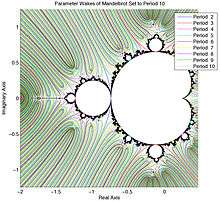
p/q-wake is the region of parameter plane enclosed by two external rays landing on the same root point on the boundary of main cardioid ( period 1 hyperbolic component).
Angles of the external rays that land on the root point one can find by :
- Combinatorial algorithm = Devaney's method
- book program by Claude Heiland-Allen
- wake function from program Mandel by Wolf Jung
p/q-Subwake of W is a wake of a p/q-satellite component of W

wake is named after:
- rotation number p/q ( as above)
- angles of external rays landing in it's root point : "If two M-rays land at the same point we denote by wake the component of which does not contain 0."[245]
Components of dynamical plane
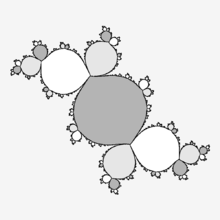 Components of interior of Filled Julia set
Components of interior of Filled Julia set Inverse iteration of Siegel disc component
Inverse iteration of Siegel disc component
In case of Siegel disc critical orbit is a boundary of component containing Siegel Disc.
For a quadratic polynomial with a parabolic orbit, the unique Fatou component[246] containing the critical value will be called the characteristic Fatou component; (Dierk Schleicher in Rational Parameter Rays of the Mandelbrot Set )
Domain
Domain in mathematical analysis it is an open connected set
Jordan domain
"A Jordan domain[247] J is the homeomorphic image of a closed disk in E2. The image of the boundary circle is a Jordan curve, which by the Jordan Curve Theorem separates the plane into two open domains, one bounded, the other not, such that the curve is the boundary of each." [248]
Dwell bands
"Dwell bands are regions where the integer iteration count is constant, when the iteration count decreases (increases) by 1 then you have passed a dwell band going outwards (inwards). " [249] Other names:
- level sets of integer escape time
Flower
Interval
a partition of an interval into subintervals
- Markov paritition[250]
Invariant
sth is invariant if it does't change under transformation
"A subset S of the domain Ω is an invariant set for the system (7.1) if the orbit through a point of S remains in S for all t ∈ R. If the orbit remains in S for t > 0, then S will be said to be positively invariant. Related definitions of sets that are negatively invariant, or locally invariant, can easily be given" [251]
Examples :
- invariant set
- invariant point = fixed point
- invariant cycle = periodic point
- invariant curve
- invariant circle
- petal = invariant planar set
Level set
- a level set of a real-valued function f[252] ( see also dwell band)
- Level set methods (LSM)
in case of :
- dynamic plane
- integer escape time
- target set : exterior of the circle ( used in the escaping test )
level set is defined :
Boundaries of level sets ( lemniscates) are
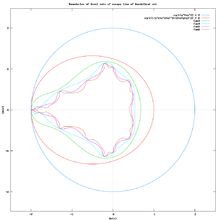 lemniscates of Mandelbrot set
lemniscates of Mandelbrot set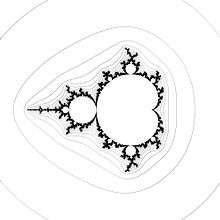 LCM/J; ER=1000
LCM/J; ER=1000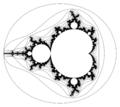 LCM/J but better algorithm, ER = 2
LCM/J but better algorithm, ER = 2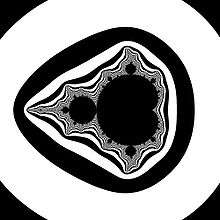 LSM/J B&W; ER = 1000
LSM/J B&W; ER = 1000 LSM/J colour ( probably made with Fractint ); ER = 2
LSM/J colour ( probably made with Fractint ); ER = 2
Locus
Cantor
The Cantor locus is the unique hyperbolic component, in the moduli space of quadratic rational maps rat2, consisting of maps with totally disconnected Julia sets [253]
Connectedness
In one-dimensional complex dynamics, the connectedness locus is a subset of the parameter space of rational functions, which consists of those parameters for which the corresponding Julia set is connected. the Mandelbrot set is a subset of the complex plane that may be characterized as the connectedness locus of a family of polynomial maps.
Planar set
a non-separating planar set is a set whose complement in the plane is connected.[254]
post-critical
"For a rational map of the Riemann sphere f, the post-critical set PC(f) is defined as closure of orbits of all critical points of f. It is proved by Lyubich [Ly83b] that the post-critical set of a rational map is the measure theoretic attractor of points in the Julia set of that map. That is, for every neighborhood of the post-critical set, orbit of almost every point in the Julia set eventually stays in that neighborhood" [255]
region
- Shell-Thron region[256]
Sepal
Target set
Elliptic case
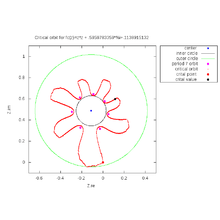
For the elliptic dynamics, when there is a Siegel disc, the target set is an inner circle
Hyperbolic case
Infinity is allways hyperbolic attractor for forward iteration of polynomials. Target set here is an exterior of any shape containing all point of Julia set ( and it's interior). There are also other hyperbolic attractors.
In case of forward iteration target set is an arbitrary set on dynamical plane containing infinity and not containing points of filled Julia set.
For escape time algorithms target set determines the shape of level sets and curves. It does not do it for other methods.
Exterior of circle
This is typical target set. It is exterior of circle with center at origin and radius =ER :
Radius is named escape radius ( ER ) or bailout value.
Circle of radius=ER centered at the origin is :
Exterior of square
Here target set is exterior of square of side length centered at origin
Parabolic case : petal
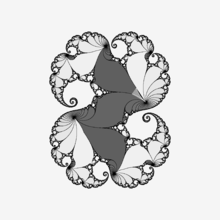
In the parabolic case target set shoul be iside petal
Trap
Trap is another name of the target set. It is a set which captures any orbit tending to point inside the trap ( fixed / periodic point ).
Test
Bailout test or escaping test

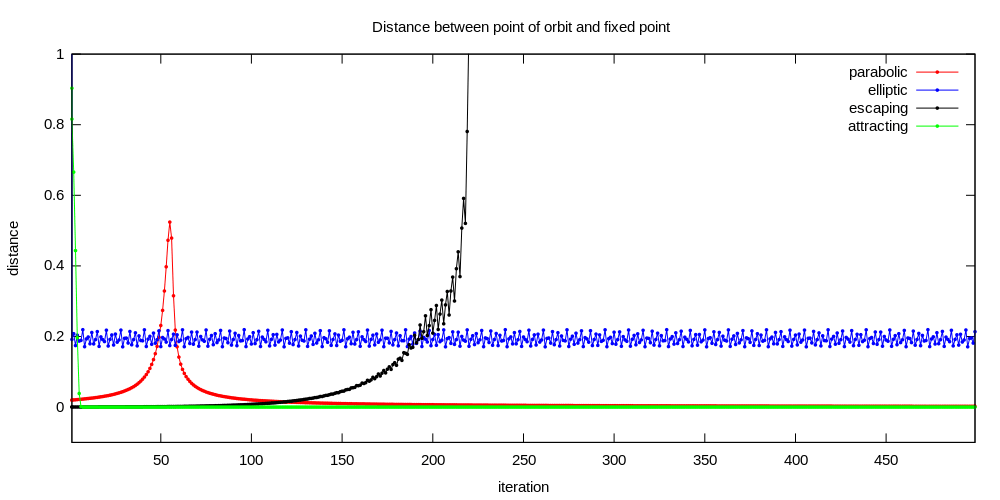
It is used to check if point z on dynamical plane is escaping to infinity or not.[257] It allows to find 2 sets :
- escaping points ( it should be also the whole basing of attraction to infinity)[258]
- not escaping points ( it should be the complement of basing of attraction to infinity)
In practice for given IterationMax and Escape Radius :
- some pixels from set of not escaping points may contain points that escape after more iterations then IterationMax ( increase IterMax )
- some pixels from escaping set may contain points from thin filaments not choosed by maping from integer to world ( use DEM )
If is in the target set then is escaping to infinity ( bailouts ) after n forward iterations ( steps).[259]
The output of test can be :
- boolean ( yes/no)
- integer : integer number (value of the last iteration)
Types of bailout test:
Attraction test
Theorem
- The Douady-Hubbard landing theorem for periodic external rays of polynomial dynamics: "for a complex polynomial f with bounded postcritical set, every periodic external ray lands at a repelling or parabolic periodic point, and conversely every repelling or parabolic point is the landing point of at least one periodic external ray." [260]
References
- ↑ haskell package : ruff-0.2by Claude Heiland-Allen
- ↑ On the Locus of Crossed Renormalization (Problems on complex dynamical systems) by Riedl, Johannes; Schleicher, Dierk
- ↑ Rational Maps with Clustering and the Mating of Polynomials by Thomas Joseph Sharland
- ↑ Topics from One-Dimensional Dynamics by Karen M. Brucks,Henk Bruin. page 265 exercise 14.2.12
- ↑ muency - internal angle ( the Mandelbrot Set Glossary and Encyclopedia, by Robert Munafo, (c) 1987-2016. )
- ↑ internal angle from the Mandelbrot Set Glossary and Encyclopedia, by Robert Munafo, (c) 1987-2017
- ↑ argument of complex number
- ↑ A Method to Solve the Limitations in Drawing External Rays of the Mandelbrot Set M. Romera, G. Pastor, A. B. Orue, A. Martin, M.-F. Danca, and F. Montoya
- ↑ Matcont - is a Matlab software project for the numerical continuation and bifurcation study of continuous and discrete parameterized dynamical systems. Leaders of the project are Willy Govaerts (Gent,B) and Yuri A. Kuznetsov (Utrecht,NL).
- ↑ quora: What-is-gradient?
- ↑ geometry by Dr. Carol JVF Burns
- ↑ What is a Curve ?
- ↑ Unit circle in wikipedia
- ↑ The Road to Chaos is Filled with Polynomial Curves by Richard D. Neidinger and R. John Annen III. American Mathematical Monthly, Vol. 103, No. 8, October 1996, pp. 640-653
- ↑ Hao, Bailin (1989). Elementary Symbolic Dynamics and Chaos in Dissipative Systems. World Scientific. ISBN 9971-5-0682-3. http://power.itp.ac.cn/~hao/.
- ↑ M. Romera, G. Pastor and F. Montoya, "Misiurewicz points in one-dimensional quadratic maps", Physica A, 232 (1996), 517-535. Preprint
- ↑ LAMINATIONAL MODELS FOR SOME SPACES OF POLYNOMIALS OF ARBITRARY DEGREE by ALEXANDER BLOKH, LEX OVERSTEEGEN, ROSS PTACEK, AND VLADLEN TIMORIN
- ↑ Models_for_spaces_of_dendritic_polynomials by ALEXANDER BLOKH, LEX OVERSTEEGEN, ROSS PTACEK,AND VLADLEN TIMORIN
- ↑ Escape lines versus equipotential lines in the Mnadelbrot set by M. Romera, Pastor G , D. de la Guía, Montoya
- ↑ The Computation of Invariant Circles of Maps Article in Physica D Nonlinear Phenomena 16(2):243-251 · June 1985 DOI: 10.1016/0167-2789(85)90061-2 1st I.G. Kevrekidis
- ↑ A Newton-Raphson method for numerically constructing invariant curves Marty, Wolfgang
- ↑ Numerical Approximation of Rough Invariant Curves of Planar Maps Article in SIAM Journal on Scientific Computing 25(1) · September 2003 DOI: 10.1137/S106482750241373X K. D. Edoh and Jens Lorenz
- ↑ SIAM J. Sci. and Stat. Comput., 8(6), 951–962. (12 pages) A New Algorithm for the Numerical Approximation of an Invariant Curve Published online: 14 July 2006 Keywords invariant manifold, polygonal approximation AMS Subject Headings 65L99, 65H10, 34C40 Publication Data ISSN (print): 0196-5204 ISSN (online): 2168-3417 Publisher: Society for Industrial and Applied Mathematics M. van Veldhuizen
- ↑ ON QUASI-INVARIANT CURVES by RICARDO PEREZ-MARCO
- ↑ Escape lines versus equipotential lines in the Mnadelbrot set by M. Romera, Pastor G , D. de la Guía, Montoya
- ↑ wikipedia : Jordan curve theorem
- ↑ Modeling Julia Sets with Laminations: An Alternative Definition by Debra Mimbs
- ↑ Laminations of the unit disk with irrational rotation gaps by John C. Mayer
- ↑ Rational maps represented by both rabbit and aeroplane matings Thesis submitted in accordance with the requirements of the University of Liverpool for the degree of Doctor in Philosophy by Freddie R. Exall July 2010
- ↑ Core entropy and biaccessibility of quadratic polynomials by Wolf Jung
- ↑ Rational maps represented by both rabbit and aeroplane matings Thesis submitted in accordance with the requirements of the University of Liverpool for the degree of Doctor in Philosophy by Freddie R. Exall July 2010
- ↑ Rational Parameter Rays of the Mandelbrot Set by Dierk Schleicher
- ↑ Critical portraits for postcritically finite polynomials by Alfredo Poirier
- ↑ Critical portraits for postcritically finite polynomials by Alfredo Poirier
- ↑ wikipedia: Filled_Julia_set
- ↑ Rational Parameter Rays of The Multibrot Sets by Dominik Eberlein, Sabyasachi Mukherjee, Dierk Schleicher
- ↑ Robert L. Devaney. "Intertwined internal rays in Julia sets of rational maps." Fundamenta Mathematicae 206.1 (2009): 139-159. <http://eudml.org/doc/283146>.
- ↑ Iterated Monodromy Groups of Quadratic Polynomials, I Laurent Bartholdi, Volodymyr V. Nekrashevych
- ↑ GROWTH OF GROUPS DEFINED BY AUTOMATA : ASHLEY S. DOUGHERTY, LYDIA R. KINDELIN, AARON M. REAVES, ANDREW J. WALKER, AND NATHANIEL F. ZAKAHI
- ↑ Douglas C. Ravenel : External angles in the Mandelbrot set: the work of Douady and Hubbard. University of Rochester Template:Webarchive
- ↑ John Milnor : Pasting Together Julia Sets: A Worked Out Example of Mating. Experimental Mathematics Volume 13 (2004)
- ↑ Saaed Zakeri: Biaccessiblility in quadratic Julia sets I: The locally-connected case
- ↑ A. Douady, “Algorithms for computing angles in the Mandelbrot set,” in Chaotic Dynamics and Fractals, M. Barnsley and S. G. Demko, Eds., vol. 2 of Notes and Reports in Mathematics in Science and Engineering, pp. 155–168, Academic Press, Atlanta, Georgia, USA, 1986.
- ↑ K M. Brucks, H Bruin : Topics from One-Dimensional Dynamics Series: London Mathematical Society Student Texts (No. 62) page 257
- ↑ Symbolic Dynamics of Quadratic Polynomials by H. Bruin and D. Schleicher
- ↑ Symbolic Dynamics and Rotation Numbers J. J. P. Veerman Phys. 13A, 1986, 543-576.
- ↑ Symbolic Dynamics of Order-Preserving Orbits J. J. P. Veerman Phys. 29D, 1987, 191-201.
- ↑ Walter Bergweiler : A gallery of complex dynamics pictures.
- ↑ Around the boundary of complex dynamics by Roland K. W. Roeder
- ↑ Image entropy by Dave O'Brien
- ↑ mathoverflow question : whats-a-natural-candidate-for-an-analytic-function-that-interpolates-the-tower/43003
- ↑ Faa di Bruno and derivatives of an iterated function ON MAY 20, 2017 BY DCHOYLE
- ↑ A Cheritat wiki : Mandelbrot_set - Following_the_derivative
- ↑ A Cheritat wiki : Mandelbrot_set - Interior_detection_methods
- ↑ MAT335H1F Lecture Notes by Burbulla (Chapter 11, 12 and 13 )
- ↑ Schwarzian-Derivative-Poster
- ↑ Schwarzian derivatives of rational functions by Alex Eremenko
- ↑ What is ... Schwarzian Derivative? (Notices of AMS Jan 2009),
- ↑ betterexplained : vector-calculus-understanding-the-gradient
- ↑ khan academy :the-gradient
- ↑ Gradient-Based Optimization by Jason Hicken, Prof. Juan Alonso, and Prof. Charbel Farhat
- ↑ gradient-descent-algorithm-and-its-variants by Imad Dabbura
- ↑ The chaotic nature of faster gradient descent methods by Kees van den Doel and Uri Ascher
- ↑ Germ in wikipedia
- ↑ Linearization of germs: regular dependence on the multiplier by Carlo Carminati, Stefano Marmi
- ↑ math.stackexchange question : is-there-any-difference-between-mapping-and-function
- ↑ Iterated function (map) in wikipedia
- ↑ evolution function
- ↑ the discrete nonlinear dynamical system
- ↑ riemann-for-anti-dummies by the LaRouche Youth Movement in Canada
- ↑ chebfun docs
- ↑ HarmonicFunction by (c) 2011 John H. Mathews, Russell W. Howell
- ↑ Connectivity of Julia sets of Newton maps: A unified approach by K. Baranski N. Fagella X. Jarque B. Karpinska
- ↑ A Beginners’ Guide to Resurgence and Trans-series in Quantum Theories Gerald Dunne
- ↑ A Primer on Resurgent Transseries and Their Asymptotics by Inês Aniceto, Gökçe Başar, Ricardo Schiappa
- ↑ Universality of Resurgence in Quantization Theories - video
- ↑ dinkydauset at deviantar :Perturbation-for-the-Mandelbrot-set-450766847
- ↑ math.stackexchange question: selecting-reference-orbit-for-fractal-rendering-with-perturbation-theory
- ↑ math.stackexchange question: coloring-the-mandelbrot-set-using-iterated-points?
- ↑ Dessins d’enfants and Hubbard trees by Kevin M. Pilgrim
- ↑ Admissibility of kneading sequences and structure of Hubbard trees for quadratic polynomials by Henk Bruin, Dierk Schleicher
- ↑ wikipedia: Magnitude in mathematics
- ↑ Hyperbolic Components by John Milnor
- ↑ Complex quadratic map in wikipedia
- ↑ Michael Yampolsky, Saeed Zakeri : Mating Siegel quadratic polynomials.
- ↑ Mandel: software for real and complex dynamics by Wolf Jung
- ↑ three-cool-facts-about-rotations-of-the-circle by David Richeson
- ↑ irrational-rotations-of-the-circle-and-benfords-law by David Richeson
- ↑ wikipedia : Dyadic transformation
- ↑ On Combinatorial Types of Periodic Orbits of the Map x↦kx (mod Z). Part I: Realization Authors: Carsten L. Petersen, Saeed Zakeri
- ↑ chaos_and_doubling map by Mark McClure
- ↑ lavaurs' algorithm in Haskell with SVG output by Claude Heiland-Allen
- ↑ SYMBOLIC DYNAMICS AND SELF-SIMILAR GROUPS by VOLODYMYR NEKRASHEVYCH
- ↑ The measure of the Feigenbaum Julia set by Artem Dudko and Scott Sutherland
- ↑ Poincaré map
- ↑ General principles of chaotic dynamics by P.B. Persson , C.D. Wagner
- ↑ Continuous time and discrete time dynamical systems by Shaun Bullett
- ↑ Continuous time and discrete time dynamical systems by Shaun Bullett
- ↑ EXPONENTIAL THURSTON MAPS AND LIMITS OF QUADRATIC DIFFERENTIALS by JOHN HUBBARD, DIERK SCHLEICHER, AND MITSUHIRO SHISHIKURA
- ↑ The Thurston Algorithm for quadratic matings by Wolf Jung
- ↑ Conformal Geometry and Dynamics of Quadratic Polynomials Mikhail Lyubich
- ↑ wikipedia: Riemann mapping theorem
- ↑ A THOMPSON GROUP FOR THE BASILICA by JAMES BELK AND BRADLEY FORREST
- ↑ math stackexchange question: explicit-riemann-mappings
- ↑ mathoverflow question: complex-function-for-mapping-a-circle-to-a-superellipse
- ↑ math.stackexchange question: explicit-riemann-mappings
- ↑ three-cool-facts-about-rotations-of-the-circle by David Richeson
- ↑ binary_shift_left
- ↑ Multiplier at wikipedia
- ↑ Internal angles and multipliers from Fractal Geometry Yale University Michael Frame, Benoit Mandelbrot (1924-2010), and Nial Neger September 3, 2017
- ↑ A Cheritat wiki-draw : Mandelbrot_set#Following_the_derivative
- ↑ Periodic cycles and singular values of entire transcendental functions by Anna Miriam Benini and Nuria Fagella
- ↑ Feigenbaum constants
- ↑ wikipedia : Rotation number
- ↑ rotation number From the Mandelbrot Set Glossary and Encyclopedia, by Robert Munafo, (c) 1987-2016
- ↑ scholarpedia : Rotation_theory
- ↑ The Fractal Geometry of the Mandelbrot Set II. How to Count and How to Add Robert L. Devaney
- ↑ An Introduction to Rotation Theory Prize winner, DSWeb Student Competition, 2007 By Christian Kue
- ↑ Complex systems simulation Curso 2012-2013 by Antonio Giraldo and María Asunción Sastre
- ↑ Weisstein, Eric W. "Map Winding Number." From MathWorld--A Wolfram Web Resource. http://mathworld.wolfram.com/MapWindingNumber.html
- ↑ wikipedia : Rotation_number
- ↑ RATIONAL PARAMETER RAYS OF THE MANDELBROT SET by Dierk Schleicher
- ↑ https://plus.maths.org/content/winding-numbers-topography-and-topology-ii
- ↑ Winding-Number by empet
- ↑ Finding the number of roots of a polynomial in a plane region using the winding number by Juan Luis García Zapataa, Juan Carlos Díaz Martín
- ↑ MATH 145: SUPPLEMENTARY NOTES by VIN DE SILVA
- ↑ wikipedia : Orbit_(dynamics)
- ↑ wikipedia : orbit (dynamics)
- ↑ Wikipedia : Complex quadratic polynomial - Critical point
- ↑ MandelOrbits - A visual real-time trace of Mandelbrot iterations by Ivan Freyman
- ↑ wikipedia : Periodic points of complex quadratic mappings
- ↑ M. Romera, G. Pastor, and F. Montoya : Multifurcations in nonhyperbolic fixed points of the Mandelbrot map. Fractalia 6, No. 21, 10-12 (1997)
- ↑ Burns A M : Plotting the Escape: An Animation of Parabolic Bifurcations in the Mandelbrot Set. Mathematics Magazine, Vol. 75, No. 2 (Apr., 2002), pp. 104-116
- ↑ Khan Academy : Mandelbrot Spirals 2
- ↑ Complex Power Towers (Or ‘mucking around with Mathematica’) by Mike Croucher
- ↑ /DarkHeart by Chris King
- ↑ Alexandre Devert blog
- ↑ codeproject : Fractals-in-theory-and-practice
- ↑ Ouadratic-like maps and Renormalization by Nuria Fagella
- ↑ Peiod From the Mandelbrot Set Glossary and Encyclopedia, by Robert Munafo, (c) 1987-2015.
- ↑ scholarpedia : Periodic Orbit for a Map
- ↑ wikipedia : Complex_quadratic_polynomial - Planes
- ↑ UC San Diego : MATH 196/296: Student Colloquium
- ↑ math.stackexchange question: entire-function-with-image-contained-in-slit-plane-is-constant
- ↑ Alternate Parameter Planes by David E. Joyce
- ↑ mu-ency : exponential map by R Munafo
- ↑ Exponential mapping and OpenMP by Claude Heiland-Allen
- ↑ Linas Vepstas : Self Similar?
- ↑ the flattened cardioid of a Mandelbrot by Tom Rathborne
- ↑ Stretching cusps by Claude Heiland-Allen
- ↑ Twisted Mandelbrot Sets by Eric C. Hill
- ↑ doubling bifurcations on complex plane by E Demidov
- ↑ On biaccessible points in the Julia set of the family z(a+z^{d}) by Mitsuhiko Imada
- ↑ Topological Variety of Buried Points by Clinton P. Curry, Logan C. Hoehn, and John C. Mayer
- ↑ Surgery in Complex Dynamics by Carsten Lunde Petersen, online paper
- ↑ Nucleus - From the Mandelbrot Set Glossary and Encyclopedia, by Robert Munafo, (c) 1987-2015.
- ↑ Siegel disks by Xavier Buff and Arnaud Ch ́ritat e Univ. Toulouse Roma, April 2009
- ↑ wikipedia : Critical point (mathematics)
- ↑ Java program by Dieter Röß showing result of changing initial point of Mandelbrot iterations
- ↑ Cut point in wikipedia
- ↑ On local connectivity for the Julia set of rational maps : Newton’s famous example By P. Roesch
- ↑ muency : feigenbaum point
- ↑ On Periodic and Chaotic Regions in the Mandelbrot Set by G. Pastor , M. Romera, G. Álvarez, D. Arroyo and F. Montoya
- ↑ fractal-faq : section 6
- ↑ Period doubling and Feigenbaum's scaling be E Demidov
- ↑ mathoverflow question : is-there-a-way-to-find-regions-of-depth-in-the-mandelbrot-set-other-than-simply?rq=1
- ↑ Fractalforums : fibonacci-and-the-mandelbrot-set
- ↑ Parameter scaling for the Fibonacci point by Leroy Wenstrom
- ↑ The Fibonacci unimodal map by Mikhail Lyubich, John W. Milnor
- ↑ [w:Point at infinity|Point at infinity in wikipedia]
- ↑ Mathoverflow question : Attractive Basins and Loops in Julia Sets
- ↑ wikipedia : Misiurewicz point
- ↑ The bifurcation diagram of cubic polynomial vector fields on CP1 by Christiane Rousseau
- ↑ A rigidity result for some parabolic germs by Luna Lomonaco, Sabyasachi Mukherjee
- ↑ http://www.mndynamics.com/indexp.html%7C program Mandel by Wolf Jung , demo 2 page 3
- ↑ Thompson-Like Groups for Dendrite Julia Sets by Will Smith
- ↑ GROWTH OF GROUPS DEFINED BY AUTOMATA : ASHLEY S. DOUGHERTY, LYDIA R. KINDELIN, AARON M. REAVES, ANDREW J. WALKER, AND NATHANIEL F. ZAKAHI
- ↑ Ouadratic-like maps and Renormalization by Nuria Fagella
- ↑ mathoverflow question : is-there-a-way-to-find-regions-of-depth-in-the-mandelbrot-set-other-than-simply?rq=1
- ↑ Bond the Mandelbrot Set Glossary and Encyclopedia, by Robert Munafo, (c) 1987-2018.
- ↑ wikipedia : Orbit portrait
- ↑ THURSTON’S ALGORITHM AND RATIONAL MAPS FROM QUADRATIC POLYNOMIAL MATINGS by Mary Wilkerson
- ↑ stackoverflow question : how-do-i-interpret-precision-and-scale-of-a-number-in-a-database
- ↑ taking-the-error-out-of-the-error-function by Fredrik Johansson
- ↑ An Introduction To Small Divisors by S. Marmi
- ↑ autodiff.org
- ↑ wikipedia : Numerical_differentiation
- ↑ Numerical Recipies In C : 5.7 Numerical Derivatives
- ↑ stackoverflow question: is-there-any-standard-way-to-calculate-the-numerical-gradient
- ↑ wikipedia : Finite difference
- ↑ wikipedia : discretization
- ↑ mathinsight : from_discrete_to_continuous_dynamical_systems
- ↑ Airplane primitive parabolic implosion by Wolf Jung
- ↑ SemiParabolicImplosion by Eric Bedford
- ↑ CANTOR BOUQUETS, EXPLOSIONS, AND KNASTER CONTINUA: DYNAMICS OF COMPLEX EXPONENTIALS by Robert L. Devaney Publicacions Matematiques, Vol 43 (1999), 27–54.
- ↑ Jean-Christophe Yoccoz Small Divisors: Number Theory in Dynamical Systems, page 46
- ↑ Integrability and Linearizability of the Lotka^Volterra System with a Saddle Point with Rational Hyperbolicity Ratio by Simon Gravel and Pierre Thibault
- ↑ On The Notions of Mating by Carsten Lunde Petersen, Daniel Meyer
- ↑ Normal Forms, Bifurcations and Finiteness Problems in Differential Equations by Yulij Ilyashenko, Christiane Rousseau, Gert Sabidussi
- ↑ towardsdatascience : gradient-descent-algorithm-and-its-variants
- ↑ math.stackexchange question: what-is-parameterization
- ↑ Perturbation for the Mandelbrot set by DinkydauSet, Apr 28, 2014, 3:46:13 PM
- ↑ PARABOLIC IMPLOSION A MINI-COURSE ARNAUD CHERITAT
- ↑ wikipedia: Approximation error
- ↑ Baby Mandelbrot sets, Renormalization and MLC Mikhail Lyubich
- ↑ ON QUASI-INVARIANT CURVES by Ricardo Pérez-Marco
- ↑ wikipedioa: Surgery theory
- ↑ Regluing of rational functions by Vladlen Timorin
- ↑ Tuning From the Mandelbrot Set Glossary and Encyclopedia, by Robert Munafo, (c) 1987-2014.
- ↑ wikipedi : dense_set
- ↑ mathoverflow question : is-there-an-almost-dense-set-of-quadratic-polynomials-which-is-not-in-the-inte/254533#254533
- ↑ fractalforums : dense-image
- ↑ A Cheritat wiki : see image showing gamma-correct downscale of dense part of Mandelbropt set
- ↑ fractal forums : pathfinding-in-the-mandelbrot-set/
- ↑ quora : Where-is-the-best-summary-on-the-meaning-of-the-terms-elliptic-hyperbolic-parabolic-as-used-in-different-disciplines-in-mathematics
- ↑ N. Marwan, M. C. Romano, M. Thiel, J. Kurths: Recurrence Plots for the Analysis of Complex Systems, Physics Reports, 438(5-6), 237-329, 2007.
- ↑ wikipedia : Conformal radius
- ↑ scholarpedia : Quadratic Siegel disks
- ↑ Julia Sets of Complex Polynomials and Their Implementation on the Computer by Christoph Martin Stroh
- ↑ fractalforums: bounding circle of julia sets by knighty
- ↑ The Mandelbrot Set and Julia Sets Combinatorics in the Mandelbrot Set - The 1/n2 rule, and deviations from it
- ↑ wikipedia : Sequence
- ↑ wikipedia : series
- ↑ Structure of Inverse Limit Spaces of Tent Maps with Nonrecurrent Critical Points by Brian Raines and Sonja Stimac
- ↑ Bifurcation structures in maps of Henon type by Kai T Hansen and Predrag Cvitanovic
- ↑ Hausdorff dimension of biaccessible angles of quadratic Julia sets and of the Mandelbrot set by Henk Bruin and Dierk Schleicher
- ↑ ADMISSIBILITY OF KNEADING SEQUENCES AND STRUCTURE OF HUBBARD TREES FOR QUADRATIC POLYNOMIALS by HENK BRUIN AND DIERK SCHLEICHER
- ↑ rosetta code : Thue-Morse
- ↑ wikipedia : series
- ↑ quora: Why-is-the-Mandelbrot-set-a-fractal? Answer by Anders Kaseorg
- ↑ The Existence and Uniqueness of the Taylor Series of Iterated Functions by Daniel Geisler
- ↑ wikipedia : Continuum in set theory
- ↑ mu-atom From the Mandelbrot Set Glossary and Encyclopedia, by Robert Munafo, (c) 1987-2018.
- ↑ Mu-atom From the Mandelbrot Set Glossary and Encyclopedia, by Robert Munafo, (c) 1987-2013.
- ↑ Island Mu-Molecule by Robert P. Munafo, 2012 Aug 18.
- ↑ Internal addresses in the Mandelbrot set and Galois groups of polynomials by Dierk Schleicher, page 31
- ↑ notes by Lyubich
- ↑ Satellite copies of the Mandelbrot set by Luna Lomonaco
- ↑ mathoverflow : precise-location-of-the-mandelbrot-bulb-attachment-to-the-main-cardioid
- ↑ ON BIACCESSIBLE POINTS OF THE MANDELBROT SET by SAEED ZAKERI
- ↑ Child From the Mandelbrot Set Glossary and Encyclopedia, by Robert Munafo, (c) 1987-2013.
- ↑ Surgery in Complex Dynamics by Carsten Lunde Petersen, online paper
- ↑ Internal addresses in the Mandelbrot set and irreducibility of polynomials by Dierk Schleicher
- ↑ Gary William Flake, The Computational Beauty of Nature, 1998. p. 125. ISBN 978-0-262-56127-3.
- ↑ Local properties of the Mandelbrot set at parabolic points by Tan Lei
- ↑ wikipedia: Classification_of_Fatou_components
- ↑ wikipedia : Carathéodory's theorem (conformal mapping)
- ↑ The intrinsic geometry of a Jordan domain by Richard L. Bishop
- ↑ fractalforums : binary-decomposition-and-external-angles by Claude
- ↑ math.stackexchange question : definition-of-markov-partition
- ↑ Norman Lebovitz : Textbook for Mathematics 27300
- ↑ wikipedia : Level set
- ↑ Limits of Polynomial-like Quadratic Rational Maps III: The Cantor Locus by Eva Uhre
- ↑ A. Blokh, X. Buff, A. Cheritat, L. Oversteegen The solar Julia sets of basic quadratic Cremer polynomials, Ergodic Theory and Dynamical Systems , 30 (2010), #1, 51-65
- ↑ Dynamics of complex unicritical polynomials. A Dissertation Presented by Davoud Cheraghi
- ↑ Hyperoperations Wiki : Shell-Thron_region
- ↑ Fractus doc by Richard Rosenman
- ↑ wikipedia : Escaping set
- ↑ fractint doc : bailout
- ↑ A landing theorem for entire functions with bounded post-singular sets by Anna Miriam Benini, Lasse Rempe-Gillen